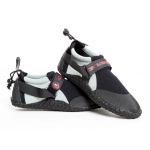Beginner’s Kayak Fishing Equipment Guide
Our team of expert kayak anglers here at Fatyak give their beginner’s kayak fishing equipment guide. We hope that by the end of the article you will feel confident in the type equipment you will need to think about purchasing to get started. In this article will cover: Choosing your Fishing Kayak and Essential Gear for Kayak Fishing, including Clothing and Footwear.
Choosing Your Fishing Kayak

Single Fishing Kayak- The Kaafu
If you are just starting out, choosing the right fishing kayak can be a daunting task. There are many options out there on the market at the moment and the choices might be overwhelming. Most models can be broken down into two categories – single seater and double seater (tandem). Below we will run through the features of our kayaks so that you have a good idea of what to look for in a great fishing kayak.
Tip:
Something to bear in mind when you a price comparing is how many extras come included in the price you are paying. Here at Fatyak, even if you choose ‘kayak only’ (without paddle or seatback), you will still get all the fishing accessories listed below, including mounting blocks, anchor trolley kit, rod holders and extra clipping points.
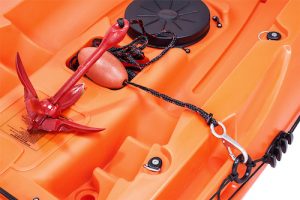
Anchor Trolley kit
What are the extras in comparison to a regular kayak?
Firstly, an anchor trolly kit, including anchor (left) comes as standard with our kayaks.
Secondly, there is an additional mounting block in the centre of the boat between the paddlers legs can be used for a number of purposes. It can hold a fish finder (a sonar device which tracks fish movements around the boat), a GPS device for navigation or a ram rod holder which can then be used to hold another rod.
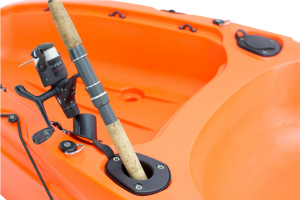
Rod holder – demonstration
Furthermore, there are two flush mounted rod holders, one on either side of the anglers seat. (In total; 4 rod holders for the tandem kayak, 2 for the single seater kayak).
The kayaks also come with numerous extra clip attachment points in the rear and central hatch to attach floating bags, bungees and other equipment.
In the tandem kayak, there is a little more room, and it includes an easy access storage tray – perfect for storing bait.
Other standard features
As with all of our kayaks, moulded in carry handles make them easy to carry but also double up as a security feature as you can put a lock through them. The kayaks have a hull design which makes them track superbly in the water, as well as it being wide enough to provide the stability a fisherman requires.
For a more in-depth comparison of our fishing kayaks, click here.
Essential Gear for Kayak Fishing
You have the boat. What next? Here is a list of items that you will need before you get going.
Clothing
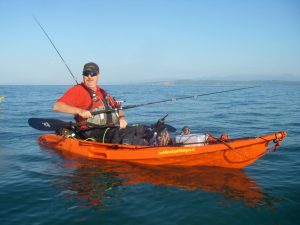
In hot weather don’t forget hat and sunglasses
Be prepared to get wet! Avoid cotton clothing as this hangs on to water and dries slowly. Choose nylon or polyester instead which will dry fast and is lightweight. If you capsize, you will be instantly cold and wet – think, how will you make sure you can recover? Warmth is critical when you are at sea, and there is a real threat of hypothermia if you are under prepared.
Many people kayak using waders and waterproof jacket, however if you choose this combination, a wading belt (to stop water coming into the waders, or at least stop some of it!) as well as a PFD (personal flotation) is essential. We would only recommend using waders if you are in relatively shallow water and not far from help just in case you capsize and waders fill up with water and you struggle to get back on the kayak.
For a lot of people, wetsuits are perfect, especially in slightly colder climates like the UK. For really cold conditions the only option is a dry suit, however these can be expensive. Ideally you want to be in clothing which primarily keeps you warm, but secondly is non-restrictive making it easier to fish.
If you are not sure, then go out for a few short paddles and test some different clothing combinations. You will soon find what works for you and your water conditions.
Above all else, you should have either a buoyancy aid (life jacket) on or similar personal flotation device (PFD) at all times.
Footwear
Think about the weather you will be fishing in. If you are going in summer, and only for shorter periods of time, then a pair of rubber or neoprene slippers (right) will probably do the trick. However, do ensure they are sandals that will not slip off your feet if you capsize and check that they have a good grip on the bottom. If you want a little bit more protection, you can buy trainers that are designed to be worn without socks in wet conditions so that the water drains out and you don’t end up with soggy feet! For really cold conditions, neoprene boots are the way forward.
Equipment
The following items are essential; each one could save your life:
PFD – A Personal Flotation Device. Wear this at all times – it will keep you afloat if you capsize. Keep your PFD knife, Radio/Mobile, Whistle and torch (if it fits easily) in or attached to your PFD so that you have these to hand in the case of an emergency. Do not put anything heavy in the pockets.
VHF/DSC Radio – A portable waterproof VHF or DSC (digital) radio will mean you can send a distress call to the local coastguards and surrounding vessels immediately without needing signal on your mobile phone. Important: It is no longer a requirement for coastguards or shipping vessels to manually look out for VHF calls on channel 16. Instead, commercial ships and the Coastguard now monitor a special digital channel with DSC radios. To transmit a distress message on this channel you will need a DCS Radio. The RNLI have a great article on this topic here.
Whistle – Attach this to your PFD. This is a good way of attracting attention of nearby vessels or people onshore.
Flares– A set of in-date flares. The day/night type are the best. Make sure they are protected in a waterproof tube. Here is an example. Some kayakers also carry high intensity chemical lightsticks in the back of their PFD, like these.
Mobile Phone – You may well not need a mobile, but it is always good to have a backup communication device. Keep it safe in a watertight case or bag.
PFD Knife – This is a knife that is always attached to your PFD. It doesn’t need to be too sharp (in fact, it’s safer if its not) and it’s use is to cut lines if you capsize and are tangled.
GPS – A GPS will tell you your location, speed, where you are heading, and how to get back. Make sure it is waterproof and has fresh batteries and is leashed to your PFD. Prices range from around £100. Click here for some good examples.
Compass – You should always have a compass (and know how to use one) to help guide you back to shore in the case of your GPS failing and visibility is poor. Never set off (especially to sea) without knowing which bearing you came from and intend to head back to to safety with. Remember a compass will not work correctly close to metal objects.
Waterproof Torch or Strobe Light – To be seen in poor visibility or when having given a distress signal. Attach this to your PFD. Here is an example.
Appropriate Clothing – This will entirely depend on the weather conditions you are heading out in. Check out this article which covers what to think about wearing.
Anchor – An anchor can be very useful in an emergency situation to stop you drifting onto rocks or further out to sea.
Food & Drink – Take more water and food than you expect to need, in case you are out on the water longer than planned.
As a last comment – you must be prepared at all times to ‘flip’ or capsize. Everything you are using must be attached to the boat before you end up in a situation where half your kit is floating downstream or out with the tide! Even your paddle should be leashed to the boat. Floating drybags can be attached to the boat using the numerous clipping points. All communication devices must either be in watertight pouches or bags and within reachable distance in case of an emergency. We would strongly advise a radio or mobile phone to be attached to your PFD, along with a torch, whistle and PFD knife.
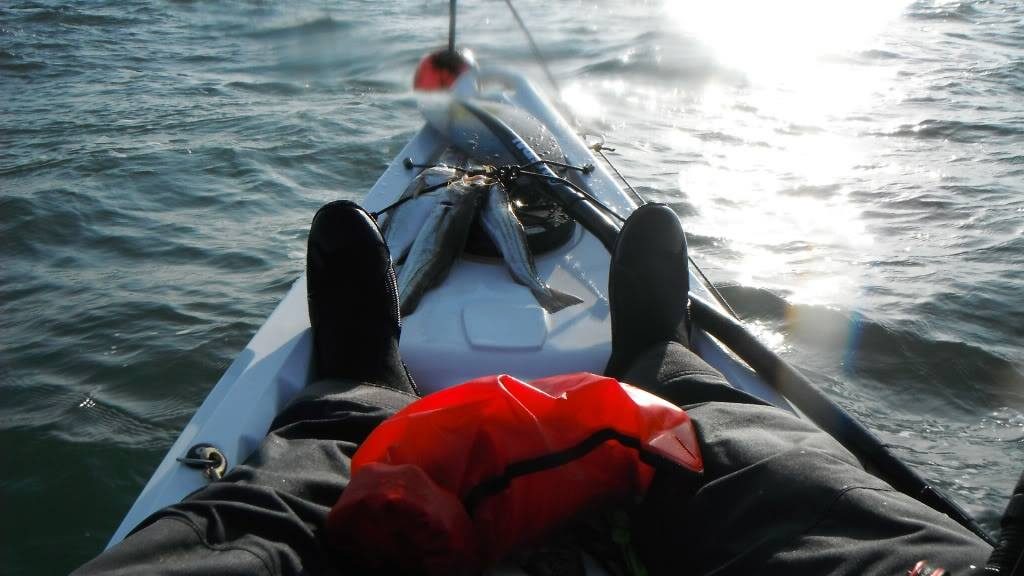
Important Last Note
If you are a novice paddler, we would advise that before you set out to fish from your kayak, you have done the appropriate training in the water. You should be able to paddle confidently, steer and capsize (and then recover) your kayak. You should also be able to perform a self rescue (getting back onto your kayak if you fall off). You should also be familiar with standard emergency procedures if something goes wrong out on the water.
We hope you have found this article useful. Have you got any gear that you can’t live without? Comment below!
Happy kayak fishing!
The Fatyak Team
Related Articles: How to Fish from a Kayak, Top UK Freshwater Kayak Fishing Locations


